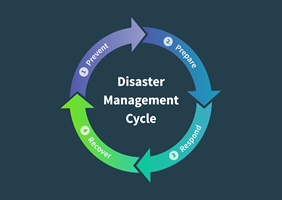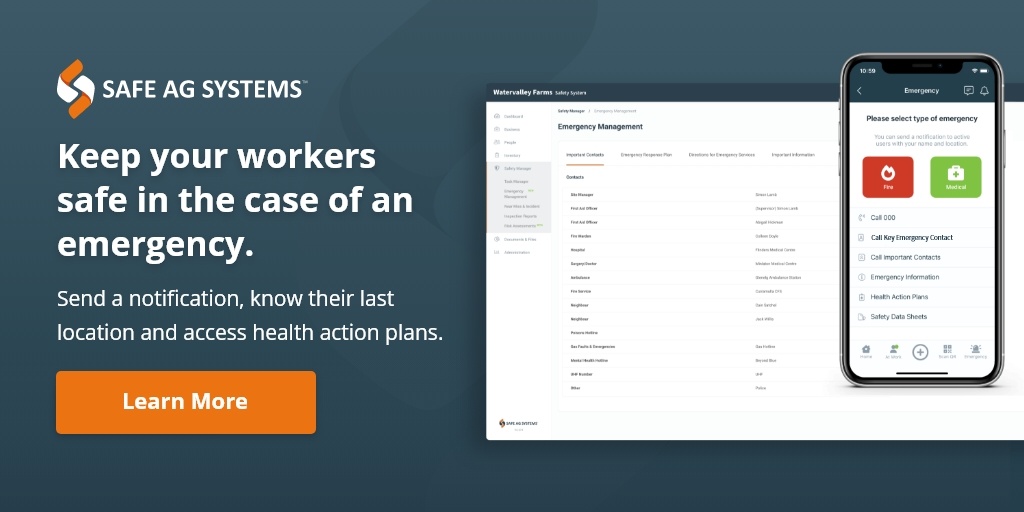Over the past 12 months around the global it would be fair to say we have witnessed an increase in emergencies and disasters. Drought, fires, cyclones, floods, and a global pandemic. All of these can have an impact on agriculture to varying degrees, depending on where you are.
The differences between an emergency and a disaster are well summed up by the City of Oxnard, CA.
An emergency is a sudden, urgent, unexpected event requiring immediate action and there are sufficient resources available to deal with it. A disaster is a calamitous event, especially if it occurs suddenly and causes great loss of life, damage or hardship and sufficient resources are not available.
Emergencies generally occur within your operations and need to be dealt with there and then, on the spot.
A disaster can happen without necessarily creating an emergency. Mother Nature is often responsible for a lot of the disasters we need to manage in agriculture, although there are other types of disasters which can impact a business’ operations and its people longer term.
The reality is that planning for an emergency or a disaster is pretty much the same although we document it a bit differently.
What measures should be taken during an emergency or disaster?
Ultimately, it’s about identifying and mitigating risks with resources available. It’s hard to predict what’s ahead but it’s a safe bet there will something you need to deal with.
Remember the 5P’s? Prior Planning Prevents Poor Performance. Think about what could happen then plan for it.
Emergency Management Plan
Most businesses have a documented Emergency Management Plan.
There’s a chance an injury or medical emergency might occur so you’ve got trained first aiders on site with suitable first aid kits.
Fires can and do happen so your firefighting equipment is maintained and ready to go.
A biosecurity issue can have significant impact if your property goes into quarantine.
Emergency plans might also include contacting neighbouring properties if there’s something that might affect them. Emergency Plans are often documented as signs in a workplace advising of who the emergency contacts are.
Disaster Management
Disaster planning is similar in process but documented more like a risk assessment. Also known as Business Continuity Planning (BCP), it helps a business plan for when things don’t go to plan. BCP guides a business to think about issues from natural disasters, pandemics, technology failure, work health and safety, economic and financial, staffing and suppliers.
Your BCP should identify the following:
- How will you sustain the supply chain?
- How will you manage staffing arrangements and protect staff health?
- What is your communication strategy to workers, contractors and suppliers?
- What are your financial implications? How will you manage cost increases and insurance?
- Do you have a contingency plan and discussed possible outcomes?
- How will you manage, review and update your plan?
This is nothing new
Yes, believe it or not – planning for pandemics was a thing prior to 2020. It’s been well known that a pandemic could, and probably would happen someday. Yet so many seemed surprised in March when Covid-19 hit.
What’s not a surprise is that in agriculture, you probably have already been and will continue to be faced with disasters you need to manage.
To plan for managing during an emergency or a disaster, try using PPRR (Prevent, Prepare, Respond and Recover).

- Prevent (or mitigate) what you can by putting in place actions to reduce or eliminate the likelihood or effects of an incident.
- Prepare for what you can’t control – take steps to ensure an effective response and recovery.
- Respond to contain, control and minimise impacts of an incident.
- Recovery is taking steps to minimise disruption and recovery times after an incident.
Here's an example
According to NFU Mutual, between April 2016 to April 2017 there were 93 farm related fires, with 51 of those related to stacked or bailed crop.
If we think about farm fires in summer, we know precautions can be taken to reduce the risks. One of the methods to prevent stack fires is storing haystacks 10 metres away from each other as well as nearby buildings to prevent a fire from spreading.
You can prepare for a fire by checking that your firefighting pump or unit is in good working order and on standby during fire season. You can also prepare by ensuring you have a sufficient water supply by setting up water tanks and portable pumps are accessible on a truck.
You respond when and as needed, to save the home, sheds, stock and as much land as you can.
Recovery will vary depending on damage of course but the better prepared you are, it’s less likely damage will occur. During recovery, take time to think for what you might do differently next time.
Not all disasters are environmental
What about a disaster of the human kind? Think about what would happen should a key person in your agribusiness be seriously injured, or worse.
What’s the plan if something happens to you?
Not all injuries will prevent people from continuing work, but some will. Farm incidents are all too common. In 2019/20, the HSE recorded 21 deaths in Agriculture, Forestry and Fishing due to people being struck by moving vehicles or objects, a fall from height, contact with machinery, injured by an animal or trapped by something collapsing.
Each year around 30 Aussies are killed on farms. It might sound morbid but plan for the worst-case scenario – fair chance nothing will happen but you and those close to you should have a plan just in case it does.
It's never too late
Start planning now for the next situation you could face. In Australia, it is inevitable that another disaster will come – what, where and when is unknown, but with plans in place you’re definitely better prepared to take it on and come out on top.
After all, the goal of any BCP should help you keep safe and keep farming.
Disclaimer: Content on this website may be of relevance to users outside of Australia, but content links and examples are specific to Australia. Please check with your local authority for your country and industry requirements.











